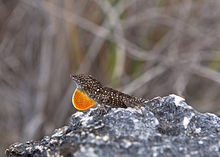- Brown Anole
-
Brown Anole 
Male Brown Anole displaying frill Conservation status Scientific classification Kingdom: Animalia Phylum: Chordata Class: Reptilia Order: Squamata Family: Polychrotidae Genus: Anolis Species: A. sagrei Binomial name Anolis sagrei
Duméril and Bibron, 1837Synonyms - Norops sagrei
The Brown Anole (Anolis sagrei) is a lizard native to Cuba and the Bahamas. It has been widely introduced elsewhere, and is now found in Florida and as far north as southern Georgia, Texas, Taiwan, Hawaii, Southern California, and other Caribbean islands.
This species is highly invasive.[1] In its introduced range it reaches exceptionally high population densities, is capable of expanding its range at an exponential rate, and both out competes and consumes many species of native lizards.[2][3][4] Its introduction in the United States has altered the behavior and triggered a negative effect on populations of the native Carolina Anole (Anolis carolinensis).
Contents
Shedding
Brown Anoles molt in small pieces, unlike some other reptiles which molt in one large piece. Anoles may consume the molted skin to replenish supplies of calcium. In captivity the molted skin may stick to the anole if humidity is too low. The unshed layer of skin can build up around the eyes, preventing the lizard from feeding and leading to starvation. This can be prevented by maintaining high humidity.
Diet
The Brown Anole feeds on insects such as crickets, grasshoppers, cockroaches, spiders, mealworms, and waxworms. They may also eat other lizards, such as the Green Anole,[5] lizard eggs, and their own molted skin and detached tails. If near water, the Brown Anole will eat arthropods or small fish, nearly anything that will fit in its mouth.
Predation
As a defense mechanism, Brown Anoles can detach most of their tails when pursued or captured. The piece that breaks off will continue to move, hopefully distracting the predator allowing the anole to escape. The lost tail will partially regrow.[6] If provoked, the Brown Anole will bite, urinate, and defecate. Predators include rats, snakes, birds and any predator that is larger than they are.
Recent work in experimentally introduced populations in the Bahamas has shown that body size in the Brown Anole may not be affected by predation, as was previously thought to be the case [7].
References
- ^ Kolbe, J.J., R.E. Glor, L.R. Schettino, A.C. Lara, A. Larson and J.B. Losos 2004. 'Genetic variation increases during biological invasion by a Cuban lizard Nature 431:177-181
- ^ Losos, J.B., J.C. Marks and T. W. Schoener. (1993). Habitat use and ecological interactions of an introduced and a native species of Anolis lizard on Grand Cayman, with a review of the outcomes of anole introductions. Oecologia 95:525-532
- ^ Campbell, T.S. 2000. Analysis of the effects of an exotic lizard (Anolis sagrei) on a native lizard (Anolis carolinensis) in Florida, using islands as experimental units. PhD Thesis, Univ. of Tennessee
- ^ Gerber, G.P. and Echternacht, A.C. 2000. Evidence for asymmetrical intraguild predation between native and introduced Anolis lizards. Oecologia 124: 599-607.
- ^ Sezen, Uzay. "Introduced brown anole displacing native green anole". http://www.vimeo.com/26310217. Retrieved July 16, 2011.
- ^ Casanova, L. 2004. "Norops sagrei" (On-line),Animal Diversity Web. Accessed July 31, 2008
- ^ Calsbeek, R., and R.M. Cox. (2010). Experimentally assessing the relative importance of predation and competition as agents of selection. Nature 465:613-616.
External links
Categories:- NatureServe Secure species
- Anoles
- Reptiles of the United States
- Fauna of Cuba
- Fauna of the Bahamas
- Reptiles of the Caribbean
- Introduced reptiles of Hawaii
Wikimedia Foundation. 2010.




